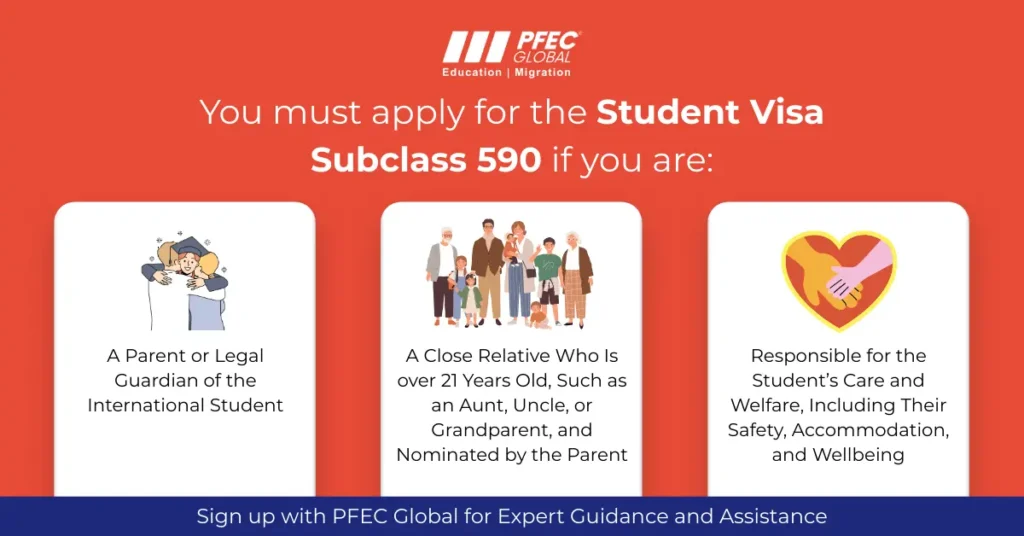Australian Partner Visa – Stay Together, Build a Future in Australia

Health insurance is an essential requirement for a worry-free experience while studying abroad.
International Medical Coverage: Health insurance provides you with the peace of mind to receive medical care anywhere in the world, ensuring you won't face overwhelming expenses.
Visa and Enrollment Support:Having health insurance can make obtaining a student visa and enrollment easier. This reduces the chances of your applications being delayed or rejected.
Financial Protection: In the event of an unexpected incident, having health insurance ensures that your medical expenses are covered. It safeguards you from potential financial stress.
Legal Compliance: Many countries create specific health insurance for international students. Securing this insurance not only safeguards your well-being but also shields you from potential legal complications and the risk of deportation. Protect yourself and ensure a smooth study experience abroad.
Comprehensive Care: Health insurance covers expenses related to hospital stays, prescription medications, mental health support, and much more.
Register with Us to Take the Next Step
Country-wise rules
The USA has a unique system that students must navigate to meet certain criteria. In contrast, Australia requires international students to have Overseas Student Health Cover (OSHC). Similarly, in the UK, students are obligated to pay an Immigration Health Surcharge (IHS) to gain access to the National Health Service (NHS). Additionally, some universities have their own specific requirements, which often include particular coverage limits in their health insurance schemes.
Selecting a plan
Recognizing the diverse needs of students, universities create customized health insurance policies that provide essential coverage. Students can conveniently enroll in these plans during their registration process, ensuring peace of mind from day one. If a university does not offer its own insurance, students must seek private health insurance, which may not fully meet their specific needs. It's crucial for universities to invest in comprehensive health insurance options that prioritize student well-being and security.
Purchasing Health Insurance
Health insurance is essential for students, and selecting the right plan is vital for their well-being. By carefully considering their unique needs, students can find a plan that offers the best balance of cost and benefits. After choosing a suitable plan and making the necessary payment, students will receive a certificate as proof of their coverage, ensuring assurance during their academic journey.
Country-wise rules
The USA has a unique system that students must navigate to meet certain criteria. In contrast, Australia requires international students to have Overseas Student Health Cover (OSHC). Similarly, in the UK, students are obligated to pay an Immigration Health Surcharge (IHS) to gain access to the National Health Service (NHS). Additionally, some universities have their own specific requirements, which often include particular coverage limits in their health insurance schemes.
Country-wise rules
The USA has a unique system that students must navigate to meet certain criteria. In contrast, Australia requires international students to have Overseas Student Health Cover (OSHC). Similarly, in the UK, students are obligated to pay an Immigration Health Surcharge (IHS) to gain access to the National Health Service (NHS). Additionally, some universities have their own specific requirements, which often include particular coverage limits in their health insurance schemes.
Australian Partner Visa – Stay Together, Build a Future in Australia
If your partner is living in Australia, being apart can be difficult. Video calls help, but they can’t replace day-to-day life together. The Australian Partner Visa gives you a way to close that distance.
Whether you’re married or in a committed de facto relationship, this visa lets you live in Australia with your partner, work legally, and access public healthcare. It also offers a clear path to permanent residency.
You can apply from within Australia (onshore) or from outside (offshore), depending on your current location and visa status.
This guide breaks down the process—types of partner visas, eligibility, documents, and timelines—so you can reunite with confidence and clarity.
What Is the Australian Partner Visa?

The Australian Partner Visa allows the spouse or de facto partner of an Australian citizen, permanent resident, or eligible New Zealand citizen to live in Australia.
You can apply under two pathways:
- Onshore Partner Visa (Subclass 820)
- For applicants already in Australia on another valid visa
- You stay in Australia while the application is processed
- You may be granted a Bridging Visa to remain lawfully during processing
- Offshore Partner Visa (Subclass 309)
- For applicants outside Australia at the time of application
- You must wait for a decision before entering Australia on this visa
- For applicants outside Australia at the time of application
Both Subclass 820 and Subclass 309 are temporary visas. If your relationship continues to be genuine and ongoing, you can apply for permanent residency under:
- Subclass 801 (onshore)
- Subclass 100 (offshore)
Expert Tip: If you’ve been in the relationship for at least three years, or two years with a child, you may qualify for immediate permanent residency at the time of decision.
Onshore vs Offshore Partner Visa – What’s the Difference?
Both visa options help you reunite with your partner in Australia. The main difference is where you’re applying from and how soon you can enter or remain in the country.
| Criteria | Onshore (Subclass 820) | Offshore (Subclass 309) |
|---|---|---|
| Apply From | Inside Australia | Outside Australia |
| Stay in Australia While Processing | Yes (with Bridging Visa) | No – wait offshore until approved |
| Work & Study Rights | Yes | Yes (after grant) |
| Access to Medicare | Yes (after grant) | Yes (after grant) |
| Leads to Permanent Visa | Subclass 801 | Subclass 100 |
Processing Times:
Visa application processing depends on the visa type, your documents, and current caseloads:
- Subclass 820 (onshore partner visa Australia): Typically takes 21 to 28 months
- Subclass 309 (offshore partner visa process): Usually takes 18 to 24 months
Delays are common during high-volume periods or if documentation is incomplete.
Expert Tip: Start early. Build a strong application with:
- Joint bank accounts or utility bills
- Photos of shared events or holidays
- Statements from friends and family confirming your relationship
- Joint lease agreements or property ownership
Both visa types eventually lead to permanent residency, allowing you to sponsor your partner for an Australia visa, build your future, and apply for citizenship if eligible.
What Types of Relationships Are Supported?
The Partner Visa Subclass 820/309 applies to couples in:
- A legal marriage (recognised under Australian law)
- A de facto relationship (usually with at least 12 months of cohabitation)
- Same-sex relationships (fully supported under the same criteria)
If you are not married, but your relationship is registered with a state or territory in Australia, the 12-month living requirement may be waived.
Expert Tip: Start documenting your relationship early. Useful evidence includes:
- Joint bank accounts or shared bills
- Travel records and holiday photos
- Joint lease agreements
- Social media history and chat logs
- Statements from friends or family
Eligibility for the Australian Partner Visa
To qualify for the onshore partner visa Australia (Subclass 820) or the offshore partner visa process (Subclass 309), you must show that your relationship is:
- Genuine
- Ongoing
- Exclusive
Core Eligibility Requirements
You must:
- Be at least 18 years old (both applicant and sponsor)
- Be in a relationship with an eligible sponsor (see above)
- Show evidence of shared life (emotional, social, financial, and household commitments)
- Pass health checks
- Submit police clearance certificates from every country where you’ve lived 12+ months in the past 10 years
Expert Insight: Ensure your relationship dates, photos, and travel history are consistent across all documents. Immigration officers check for any mismatches.
Step-by-Step Guide to Apply for the Australian Partner Visa
Applying for the Australian Partner Visa requires careful preparation and the right documentation. Here’s a practical breakdown of what to do:
Step 1: Gather Identity and Relationship Documents
Prepare:
- Your passport, birth certificate, and visa history
- Evidence of your relationship:
- Joint bank statements
- Photos of shared life
- Rental or mortgage documents
- Travel bookings
- Joint bank statements
- Your partner’s:
- Passport
- Citizenship or residency proof
- Income or employment records
- Passport
Expert Tip: Collect at least 6–10 strong documents that show you live as a couple and share responsibilities.
Step 2: Create Your ImmiAccount
Visit immi.homeaffairs.gov.au and create an ImmiAccount.
- This is where you’ll submit your visa and sponsor forms
- Upload documents
- Track progress
- Pay the visa fee
Step 3: Lodge Your Application
- You must complete Form 47SP (Partner Visa application)
- Your partner must complete Form 40SP (Sponsorship for a Partner)
- Upload all documents and pay the visa fee:
- AUD 9,095 for most applicants (covers both temporary and permanent stages)
- AUD 1,515 for Prospective Marriage Visa holders applying on time
- AUD 1,920 if you held a Prospective Marriage Visa but missed the transition deadline
- AUD 9,095 for most applicants (covers both temporary and permanent stages)
Each family member included in the application will incur an additional fee.
Note: All forms and evidence must match. Inconsistencies can delay your visa.
Step 4: Complete Health and Police Checks
- Attend a health examination with a panel-approved doctor (you’ll receive a HAP ID after lodging)
- Submit police clearances from every country where you’ve lived for 12+ months over the past decade
Step 5: Provide Biometrics or Attend an Interview (If Requested)
Some applicants may be asked to:
- Submit biometric data (fingerprints and photo)
- Attend an interview to discuss your relationship
Keep your information consistent with what you’ve already submitted.
Step 6: Wait for the Outcome
- Subclass 820 (onshore partner visa Australia): Processing takes around 21 to 28 months
- Subclass 309 (offshore partner visa process): Processing usually takes 18 to 24 months
You can track progress through your ImmiAccount. Incomplete or inconsistent applications will delay your case.
Expert Insight: Upload your documents early. Don’t wait for a request. Pre-loading your evidence can reduce wait times.
Documents Required for Partner Visa Australia
Whether you’re applying for the onshore partner visa Australia (Subclass 820) or the offshore partner visa (Subclass 309), your application must be backed by clear, well-organised documentation.
Immigration assesses your identity, your relationship, and your sponsor’s ability to support you. Submitting thorough, consistent evidence is critical.
- Identity Documents
Provide documents for both the applicant and sponsor:
- Valid passports
- Birth certificates, national IDs
- Copies of previous visas, if applicable
- Relationship Evidence
You must show your relationship is genuine, ongoing, and exclusive. Recommended documents include:
- Joint bank account statements
- Shared lease or utility bills
- Travel bookings showing trips taken together
- Photos from events, holidays, or family functions
- Screenshots of social media posts, messages, or emails over time
Expert Tip: Use a timeline format. Group evidence by year or life event to show how your relationship developed.
- Sponsor Documents
Your partner must provide:
- Australian passport, citizenship certificate, or permanent resident visa grant
- Recent payslips, tax returns, or employment letters showing financial capacity
- Health and Character Checks
These apply to both the applicant and included family members:
- Police clearance certificates for each country you’ve lived in for 12+ months (last 10 years)
- Health examinations by a panel doctor (book using your HAP ID)
- Form 888 – Statutory Declarations
Two Australian citizens or permanent residents must complete Form 888, declaring they know your relationship is genuine.
- Must be signed in front of an authorised witness (e.g., Justice of the Peace)
- Should include personal stories, such as shared experiences, family meet-ups, or trips
Expert Insight: Strong Form 888s include specific dates, real observations, and emotional detail. Avoid generic or copied statements.
Additional Notes
- All non-English documents must be officially translated by certified translators
- Ensure consistency across all documents—names, dates, and addresses must match
Australian Partner Visa Processing Time and Fees
| Visa Type | Typical Processing Time |
|---|---|
| Subclass 820 (Onshore) | 21 to 28 months |
| Subclass 309 (Offshore) | 18 to 24 months |
Your application may take longer if:
- Your documents are incomplete or unclear
- You delay health or police checks
- Your relationship evidence lacks depth or consistency
- You apply near your current visa’s expiry date (for onshore)
Expert Tip: Upload all documents in one complete, labelled batch. Avoid piecemeal submissions and low-resolution scans.
| Item | Estimated Cost (AUD) |
|---|---|
| Main Visa Application | 9,095 |
| Health Checks | Varies (AUD 250–400 average) |
| Police Clearances | Depends on issuing country |
| Translations (if needed) | Based on language/document type |
- The main visa fee covers both the temporary and permanent stages
- Visa fees are non-refundable
- Sponsors do not pay a separate fee
Use the Visa Pricing Estimator for a tailored estimate, especially if you’re adding family members.
What Happens After You Get the Partner Visa?
Once your Australian Partner Visa is approved, your new life together officially begins. But there are still key steps ahead.
Temporary Partner Visa Stage
With Subclass 820 (onshore) or Subclass 309 (offshore), you can:
- Live, work, and study in Australia
- Access Medicare, Australia’s public health care system
- Travel freely in and out of the country while your permanent visa is assessed
Moving to Permanent Residency
After two years, you may become eligible for the permanent partner visa:
| Started With... | Apply For... |
|---|---|
| Subclass 820 (onshore) | Subclass 801 (PR) |
| Subclass 309 (offshore) | Subclass 100 (PR) |
To qualify for the permanent stage:
- Your relationship must still be genuine and committed
- You’ll need to submit new relationship evidence
- You must meet health and character requirements again
Faster PR Pathway: You may be granted PR sooner if:
- You’ve been in the relationship for 3+ years, or
- 2+ years with a child from the relationship
Expert Tip: Keep building your evidence over time—bank accounts, updated leases, travel, and photos. Immigration requires fresh proof for your PR stage.
Why Apply with PFEC for Your Australian Partner Visa?
At PFEC Global, we know your visa is more than just paperwork—it’s your future with your partner.
That’s why we provide:
- Step-by-step guidance for both Subclass 820 and Subclass 309 applications
- Help with gathering and reviewing relationship evidence
- Support for GTE (Genuine Temporary Entrant) statements if needed
- Advice for your sponsor on their legal obligations
- Training for potential partner interviews
- Ongoing help through to permanent residency
With over 15 years of experience and a 98% success rate, PFEC has helped thousands of couples start their lives together in Australia—smoothly and stress-free.
Expert Insight: A well-prepared file avoids delays and refusals. Our team ensures your application meets every requirement, clearly and confidently.
Ready to Apply for Your Australian Partner Visa?
You deserve to live with your partner—without long-distance stress or uncertainty. Let PFEC help you make that future a reality.
📞 Book a free consultation with a PFEC Partner Visa expert
📄 Download our Partner Visa Checklist to prepare your documents without confusion
🤝 Get trusted support from people who understand both Australian law and your personal journey



What are my options and possibilities for submitting an Australian PR application?
Depending on your situation, you have many options when applying for an Australian Permanent Residency (PR). The Skilled Work Regional (Provisional) Visa (Subclass 491) is for regional employment; the Skilled Nominated Visa (Subclass 190) is for skilled workers who need state or territory nomination. There are several routes for family sponsorship and employer-sponsored visas, each with particular perks and requirements
If I don't have enough points to submit an application for a PR. What are my options?
If your points total is not enough for a PR application, think about being nominated by a state or territory, which may provide more points. Getting additional job experience, taking language exams like the PTE or IELTS, or going to further school in Australia to improve your credentials are all good ways to improve your English.
Does applying for a new course and student visa when I know my TR (Temporary Resident) is about to expire present any risks?
Applying for a new PR pathway courses in Australia and a student visa while your Temporary Resident visa is about to expire might be dangerous. To prevent possible visa denial, make sure your application is complete and satisfies all Department of Home Affairs standards. Learn the terms of any bridging visa that could be applicable throughout the application process, and if you’re not sure whether your application is complete or if you qualify, get expert help.